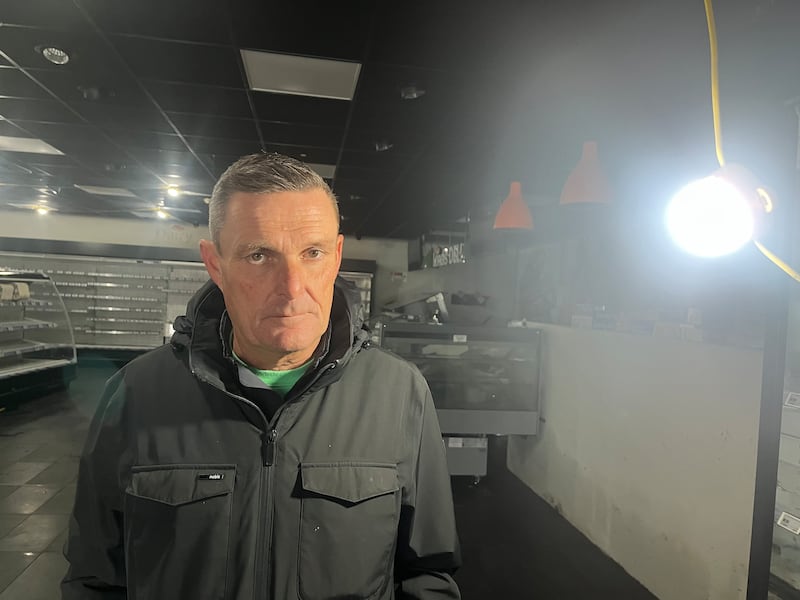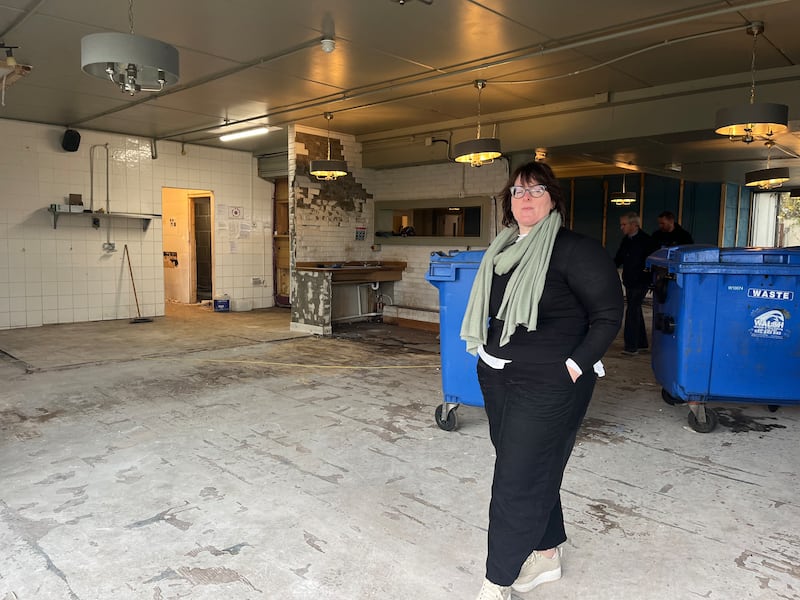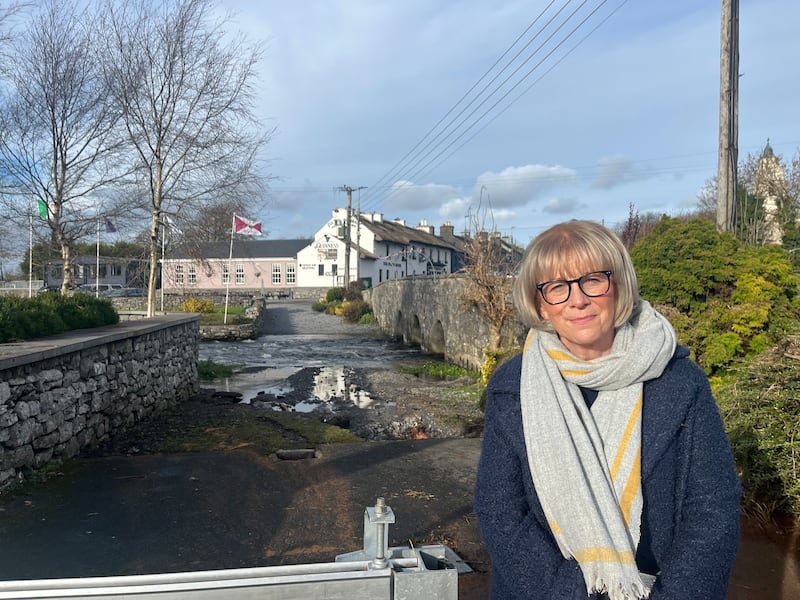Just after 4am on Monday, when the wind began pounding violently against his bedroom window, Ciarán Oliver got up and rushed down to Galway Docks.
High tide was due at 4.30am. Oliver, an experienced trawler fisherman and sailor, knew instinctively that the ballistic winds of Storm Debi meant trouble.
He had two boats berthed in the dock. His nephew, Morgan Oliver, also a fisherman, had separately gone to nearby Claddagh Basin, on the shores of the river Corrib, to secure his own boats.
For his part, Ciarán arrived just in time to see the waves wash over the top of the quay on to the road.
RM Block
“We knew this storm was building up in the Atlantic and was big. But sometimes it’s difficult to predict how it will work out,” he said.
With this one, it all happened so quickly, almost without warning.
Within minutes of arriving Ciarán could see the boats, driven by the gusts, were above the quay wall and floating across the road
“The depth of the water is usually about five metres on full tide at the docks. But It came close to seven metres on the night, I’d say. The swell was up over the road and the wind was howling. The wind was at its worst I’d say at 4.40am.”
Within minutes of arriving Ciarán could see the boats, driven by the gusts, were above the quay wall and floating across the road. Fighting against the waters lapping around his knees and ferocious gusts, he eventually managed to push them back to the dock.
A few hundred metres away, Morgan was also involved in a macabre dance, struggling against a rapidly deteriorating situation in the Claddagh Basin. Within minutes, waist-high water was surging on to the road around him and he found himself in a losing battle against the wind and waters to keep the boats at their berths.
The storm receded as quickly as it surged. Within 10 minutes the tide had retreated but left its mark behind. Three boats, including Morgan’s, were left stranded on the banks. Dozens of cars in Salthill, Raven’s Terrace and Flood Street (named for a reason) were submerged.
Communities along inner Galway Bay stretching from the city to the Burren in Co Clare, were hit by the perfect storm. It left a trail of destruction from Maree right down to Kinvara along the Co Galway coast, flooding buildings, upturning boats, submerging cars and collapsing roads.
“It wasn’t a flood. It was a tsunami,” said Galway West TD Noel Grealish. “It came out of nowhere and swamped everything. If it happened at 4.30 in the afternoon, there would have been loss of life.”
Only a handful of people witnessed the frightening spectacle in the middle of the night. One was Ronan Hennigan. He had been called at 4.30am and arrived minutes later in the village of Clarinbridge, lying about 150 metres from the seashore.
The winds were so strong that he had to shield behind a building to watch what was happening. In the shopping centre on lower ground, he could see the water rise to five feet and engulf the buildings. His heart sank. One of them was his Londis supermarket.

Two days later, Hennigan stands in the gloom of his premises. There is no electricity so temporary bulbs have been strung across the ceiling. They cast enough light to reveal the extent of the damage. What was a supermarket has been reduced to an empty husk. There is nothing left except battered display fridges and torn-up floors.
“There is €200,000 or so of stock all put in skips,” said Hennigan, who reckoned the damage will run to €700,000 or more. There was a flood here before in 2018 but it was containable. This one was different; it was all-engulfing. As he talks, he is quivering with emotion but also with some anger.
Of all the places in Co Galway, it is Clarinbridge, specifically the lowest part of the village which was worst affected by far. Most of the 11 businesses in the shopping centre were destroyed.
Next door to supermarket Londis is Aileen McPhilbin’s hair salon. The water ruined all the equipment, furniture and surfaces. “It’s all destroyed,” she says simply.
It’s the same for Lisa O’Flynn, who runs a health and beauty spa. She says the 2018 floods were like a “bad leak”. “There were centimetres of water and it took a couple of days but we got back quickly. Now it’s different.”
You can see why. Everything, including the treatment tables and showers, are no longer usable.
Most of the shops here have had to close their doors, some with little prospect of reopening in the near future. All depend on each other. If some don’t open, that will have a knock-on impact for the viability of others
Further down, the popular Poppyseed Gourmet Café has also been ravaged.
“It has been catastrophic for us. We’re back to shell and core,” says its owner Anne Forde.
“Pretty much everything is ruined. All our chairs had fabric in them. We had new pieces of cooking equipment. All of our display fridges are gone.”

Among the only things standing is a brand new oven in the kitchen, which she suspects has been rendered unusable because of seawater.
Most of the shops here have had to close their doors, some with little prospect of reopening in the near future. All depend on each other. If some don’t open, that will have a knock-on impact for the viability of others.
“The shopping centre is all of us. We need to stand together. It’s a community thing,” said McPhilbin.
Local TDs, Fine Gael’s Hildegarde Naughton and Ciaran Cannon, Fianna Fáil’s Éamon Ó Cuív and Grealish all visited the affected areas on Monday and all quickly contacted the Government.
The following morning, Minister for Enterprise Simon Coveney secured agreement to sanction emergency funding for flood-affected areas to be extended to Galway. The three local TDs agreed that for places such as Kinvara and Maree the €100,000 maximum for businesses would probably be enough. But not for Clarinbridge.
This explains Ronan Henigan’s anger. He was covered by insurance in 2018 and it cost €500,000 to reopen the premises. But he could not get insurance after the 2018 flood because the area was classified as a flood plain. What’s on offer from the Government will cover only a fraction of his costs. His business faces ruin.
Local Fianna Fáil councillor Martina Kinnane reckons the overall costs will run into millions. She believes the Government needs to have a Covid-like response and introduce emergency measures. The first measures are compensation, she argues, but after that, she wants action.
Ministers were talking about “feasibility studies”, she says, but glass walls, stone walls and barriers would be required to keep the sea out as emergency measures to give reassurance to communities.
‘This is about the future of the community in Clarinbridge. If the flooding is happening here today, it could be somewhere else tomorrow, so we need to get this right. So if Clarinbridge has to be the catalyst for big change, so be it’
— Martina Kinnane, Fianna Fáil councillor
Long term, Kinnane believes, people need to have a serious and honest conversation about avoiding similar events in the future.
Part of that, she argues, would be to move vulnerable buildings off the flood plains that cover south Co Galway.
“There is an area not too far from the shopping centre in Clarinbridge that would be suitable for a relocated centre,” she says.

She knows the suggestion would be radical and expensive but asked if there is an alternative long-term, given that it has happened twice in five years.
“This is about the future of the community in Clarinbridge. If the flooding is happening here today, it could be somewhere else tomorrow, so we need to get this right. So if Clarinbridge has to be the catalyst for big change, so be it,” she says.
With predictions that climate change will bring fiercer storms and rising sea levels in future, the 30 minutes of mayhem in the early hours of Monday morning served as a timely reminder of how vulnerable our coastal communities can be and how problematic dealing with them will be in the future.





















